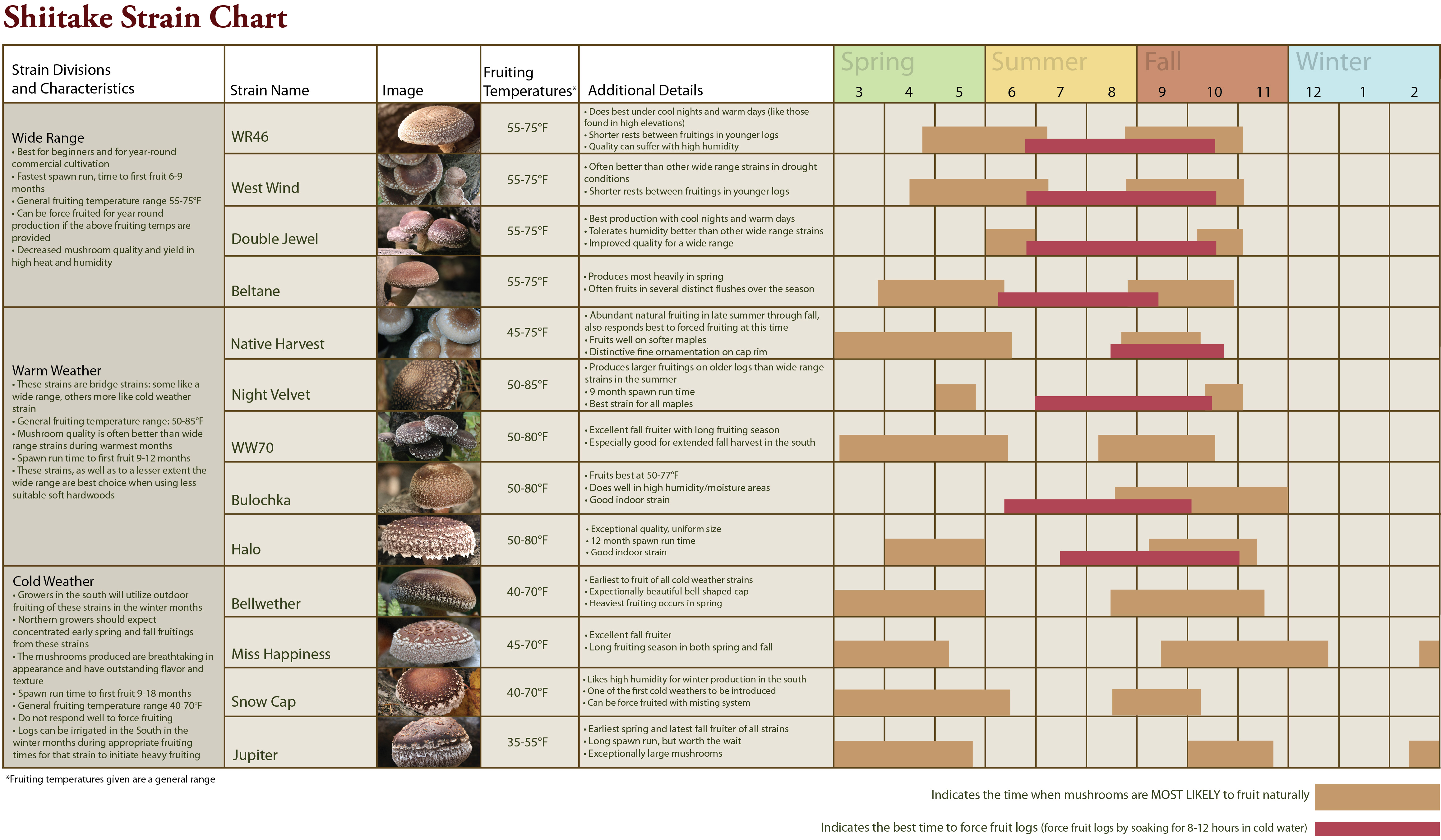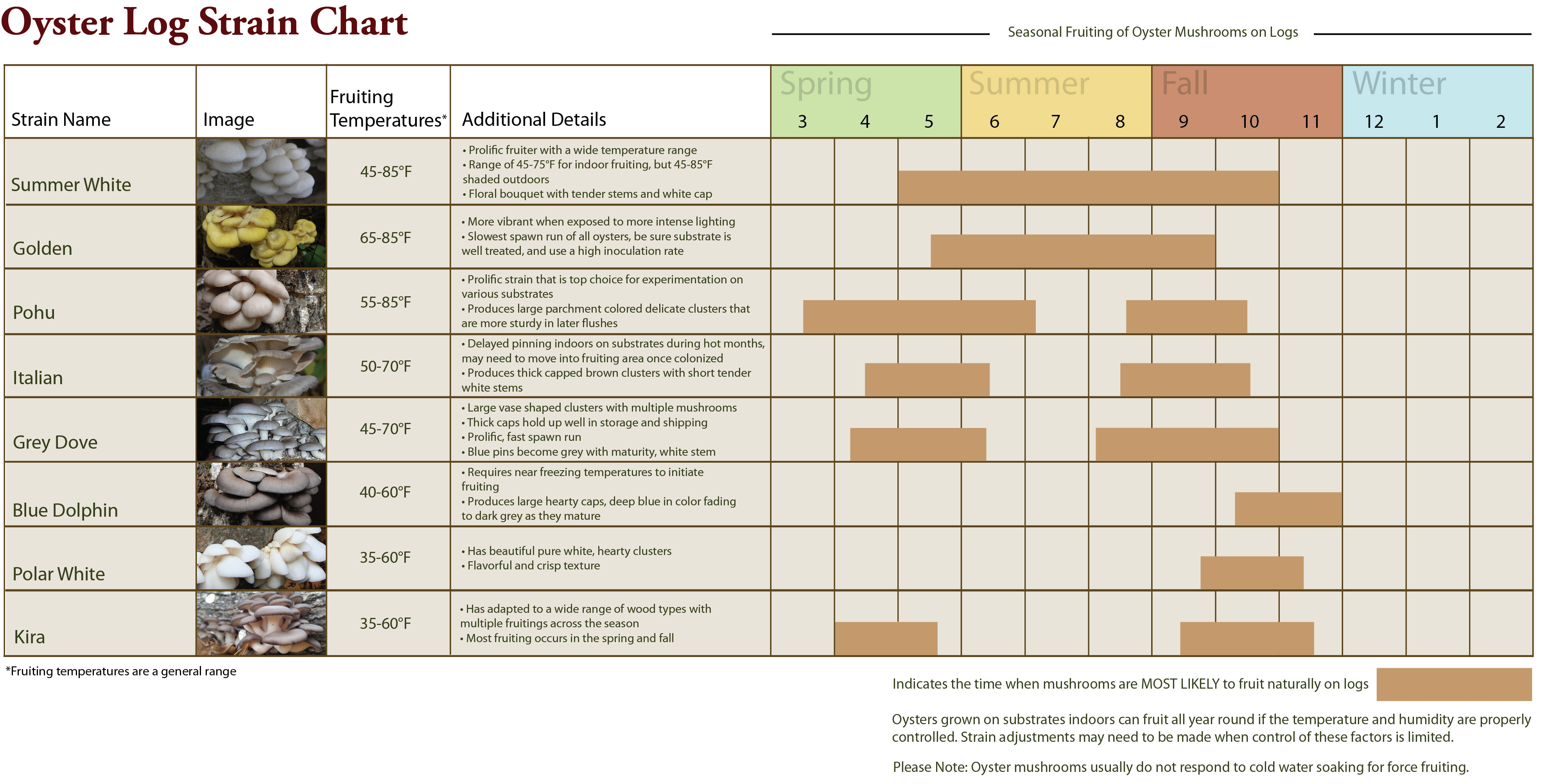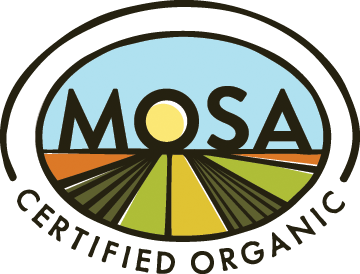Planting & Harvesting
When To Plant
The ideal time to plant mushrooms depends on where you are growing them - indoors or outdoors.
Indoor growing can be done year round in a climate controlled room! Often times indoor growers plant regularly on a scheduled cycle throughout the year to ensure continuous mushroom production.
Outdoor growing is more dependent on Mother Nature and the seasons. Most mushroom varieties are perennial crops that can be planted throughout the growing season, starting as soon as outside daytime temperatures reach 40°F or higher consistently. For growers in warmer climates, this may mean that planting can be done through- out most of the calendar year. For growers in the cooler climates, it is best to capitalize on the shorter growing seasons and try to plant in the spring or early summer to speed up the time from planting to picking your first mushrooms! If your region experiences frosts and heavy winters, then be sure to plant at least 4 weeks prior to the first frost. Most mushrooms go dormant for the cold winter months then begin growing again the following spring. Below is some general information on when to plant your mushrooms and expect your harvests:
Logs
Important: Not all trees make good mushroom logs. Please read "Selecting Logs for Mushroom Growing" first!
Spring is generally the best time to plant mushroom logs for several reasons. First, it is best to cut logs during the dormant season before the buds swell in the spring. Logs can be stored until planting when the daytime temperature consistently reach 40°F or higher. Logs should not be stored longer into the warmer months, so spring planting is ideal. Second, planting in the spring allows more of the growing season for the mushroom to colonize the log. Once planted, most mushroom logs require a minimum of 5 months before they are capable of producing mushrooms. Spring inoculated logs may be ready to fruit their first mushrooms as soon as fall. If inoculated later in the year, logs are typically not ready to fruit until the following year. Larger logs and those planted with plug spawn will take longer to colonize until fruiting.
Below is a general guideline for the time from planting to fruiting for our mushroom varieties:
Shiitake: Logs typically begin fruiting 5-18 months after planting, depending on strain and temperature. If planted in the spring, the season may be long enough to provide the first Shiitake in the fall following inoculation. It is not uncommon, however, that Shiitake logs take until the following year to produce their first mushrooms. Once fruiting begins, Shiitakes will develop when the weather conditions are ideal for that particular strain. Some varieties can be force fruited to produce Shiitake even throughout the warm months. Logs often fruit for 4-8 years. Refer to the chart below for more specific information on Shiitake strains and fruiting times:
Oyster: Logs typically fruit 3-12 months after planting, depending on strain, outside conditions and temperature. Logs often fruit for 2-4 years. Refer to the chart below for more specific information on strains and their fruiting schedule:
Lion's Mane and Comb Tooth: Logs may take up to 2 years before they are ready to produce mushrooms, then they generally fruit in the spring and fall for several years.
Olive Oysterling: Logs typically fruit the first fall a full year after inoculation. Logs produce for several years.
Nameko: Logs typically fruit the first fall a full year after inoculation. May fruit multiple times during an extended fall season. Logs produce for several years.
Reishi: Logs typically fruit the first summer a full year after inoculation. It thrives in warm, humid conditions with long growing seasons. Logs produce for several years.
Maitake/Hen of the Woods: Logs typically fruit the first fall and may fruit up to 8 years.
Chicken of the Woods: Logs typically fruit the first fall after planting. Logs produce for several years.
Outdoor Beds
Several of our mushrooms can be grown in beds outdoors. These are some of the easiest mushroom varieties to plant - simply find a space and sprinkle spawn within layers of the appropriate substrate - straw, wood chips, compost, or mixed organic materials. Mushroom beds should remain moist, so at least partial shade is best. We like to plant beds under conifer trees, shady side of the house, in and amongst ornamental or vegetable plants, where the grass struggles to grow, or any other area that could be mulched. These mushroom varieties are planted similarly, however, they grow on different materials - please read below or refer to their instruction sheets for more detail!
Wine Cap: Wine Cap can be grown in straw or wood chip beds. Depending on inoculation rate and weather conditions, these beds may be capable of fruiting mushrooms as soon as 2-3 months after planting. Thick beds and those made with wood chips only may take up to 4 months to begin producing. If planted in the spring, mushroom production is common later in the summer and especially fall. Late summer and fall planted beds typically will not produce until the following summer in northern climates with short growing seasons. Areas with moderate winters may still achieve same year first fruiting. Wine Cap fruit well throughout the growing season when the temperatures dip below 80°F - especially after a heavy rainfall. Beds produce for 1-3 years.
Almond Agaricus: This is our only annual crop mushroom. It is a tropical variety that thrives in warm, humid areas and grows on compost. We've tested this mushroom on every kind of compost we could get on hands on and all of them worked. This mushroom can be one of the most prolific varieties if grown successfully! For northern growers, plant as early in the season once temperatures are consistently above 60°F and well past the risk of last frost to enjoy a long season and maximize production. Beds are typically ready to fruit 1-2 months after planting. Almond mushroom production is directly related to bed moisture - water the bed heavily to enjoy a flush approximately one week later. Beds will continue to fruit until temperatures drop below 50°F or when the bed is exhausted. Southern growers may be able to cultivate this variety into later months dependent on temperature and weather.
Wood Blewit: Wood Blewit can be planted throughout the season - spring through early fall as late as four weeks before the first frost. Construct beds by layering spawn with a mixture of organic materials such as leaves, grass clippings, bark, twigs, pine needles, and compost. Beds will typically take one full year prior to producing their first mushrooms. Check beds regularly in the fall when these mushrooms typically fruit. Beds last 2-3 years.







